Main Sections
Front Page
SportsValley VitalsIt's in the StarsStarwiseArchivesLinksAbout The VoiceContact Us
|
A Stitch In Time Meet Addison County Quilters
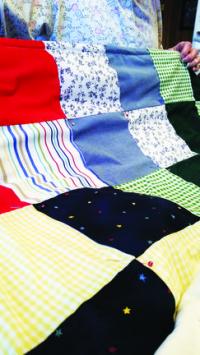
photo by provided |
| 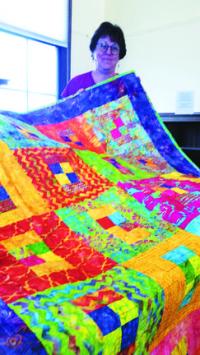
photo by provided |
| 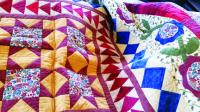
photo by provided |
| 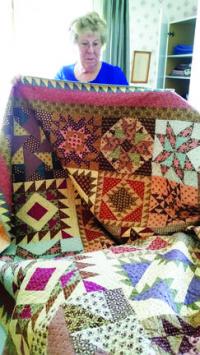
photo by provided |
| 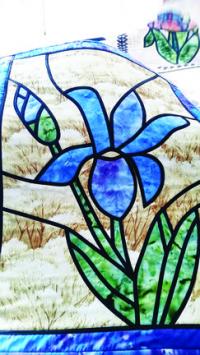
photo by provided |
|
Monday January 1, 2018
By Cookie Steponaitis
Quilting is indeed a blast from the past. It is a creative process that for many different reasons has been a part of cultures spanning the globe. Quilts have been made to provide warmth, for their beauty and skill, linking generations and exploring color, texture and patterns as an art form. Still others have used them as gifts. No matter the reason, the process of quilting can be traced back to ancient Asia and Africa where three different layers of fabric were joined together to become a quilt. With a top, batting and backing, quilts are the underpinning for garments and beds spanning almost four thousand years across cultures.
Women of the eleventh century used quilts to pad the armor of knights against rubbing and chaffing. Women of the 18th century used quilted petticoats and men quilted waistcoats. At that time quilting for bedding became popular and the earliest settlers in the New World came with the quilting skill set and quilts were made for the homes they would build. While styles and materials would change over time, quilts were both utilitarian and for pleasure as they are for today’s quilters.
Addison County boasts a strong quilting community in years of experience and diversity of backgrounds. In speaking to local and longtime quilters Peggy Reed, Karen Quigley and Ann Russet, there are as many ways to quilt as reasons to get involved. Each came to quilting their own way and at different times in their lives and view a trip to a great fabric store as something of a euphoric experience. Therefore the first piece of advice for future quilters out there is choose your shopping companions well for a great fabric store is worth five hours at the very least.
Quilter Ann Russet counts herself as new to the quilting. While she has made quilts for each of her children and several of her grandchildren, Russet taught herself to quilt and started for her own pleasure. With over fifty quilts that she has constructed since her husband passed away thirty-two years ago, Ann jokingly points to her current project and remarks, “This one is for me. So far, I have given away every quilt I have ever made and don’t get me wrong, I am glad each of my children has one and some of my grandchildren have some, but this one I do intend to keep.” Then with a sigh and chuckle Russet amends her comment to, “Well, we’ll see how that goes.” To date Russet’s largest quilt was for a queen size bed and involved more than 400 squares. She enjoys the creative process and will start a project and then put it down for a while. Ann’s other love includes working with baskets, cooking and sewing. She finds time now that her family of fifteen children is all grown but has a running list of grandchildren who would love their own quilt from grandma Ann. Russett shared one great memory when she helped a granddaughter learn how to quilt in time to enter Addison County Field Days. “It was hard because I could not touch it,” explains Ann. “I told her ideas and I supported her, but did not even touch the quilt while it was in construction. It did go well though! She earned a Blue Ribbon.”
Vergennes Quilter Karen Quigley found quilting in the early 1970’s. An avid seamstress, Quigley picked up a needle and thread when she was thirteen and learned from her sister how to make her own clothing. Quilting was not a part of the sewing culture in the early 1970’s and there was almost no one giving classes. Quigley found a book that contained traditional colonial pattern quilts and began to work. “After quilting took off and became popular there were quite a few of us,” shared Quigley. “We would meet up in the fabric store and help each other.” For Quigley quilting has grown and evolved with her. Creating quilts at first for sale, Quigley made and sold between 80-100 quilts. Most went to contract engineers coming into Simmons Precision from out of state who were infatuated with the Made in Vermont label. Several of the men actually began to quilt and loved the exactness of the angles, patterns and patterns that the colonial quilting practices provided.
It was the 1990’s when Quigley’s focus began to change and her quilting with it. Still a great blend of artistic expression, utilitarian use and therapy, Quigley fell in love with bright colors and patterns that she again found in books. Filing away the traditional patterns, Quigley began blending colors, patterns, shapes and designs to create warm and vibrant quilts that reflect the personality of the artist and potential owners. Currently Quigley has a stockpile of quilts she has made and for the past few years has only been putting her work out in public as donations at fundraisers like St. Peter’s Penny Fair and Silent Auction, St. Peter’s Craft Fair and the Greek Dog Rescue Raffle. Just as quilting has evolved for Quigley so have the tastes of the American people. “Some people look at handmade quilts and say why would I want to pay that much money for a quilt when I can get it at Walmart for a much cheaper price?” explains the quilt artist. “While there are still people out there looking for heirloom quality or top quality for their own homes, the market is flooded with cheap products that are easy to access.”
Remarking that she is a quilter that “does not stay inside of the lines,” Quigley’s skill level allows her to complete intricate quilts in fractions of the time it takes many. “I think making a quilt is like reading a wonderful book,” shared Quigley. “I can’t stop until I get to the end. I have to see how it comes out and see the finished product.” Delighted to see men getting into quilting in record numbers, Quigley is pleased there are a few younger quilters on the way up, but does worry because the idea of made at home is no longer the norm. With schools not teaching Home Economics, sewing or other traditional hands on trades, many arrive at the process like Quigley, because of curiosity or meeting people at the fabric store. Quigley has an intense appreciation for the skills of the early American quilters and has marveled at quilts in museums and in family collections. Sewn completely by hand and by candlelight, the quality of what was produced is shockingly superior. While Quigley has enough fabric and patterns stored away to survive any drought on material availability, she has a running mental list of the patterns and ideas she has yet to try. As quilt number 150 nears completion, quilting has not outgrown Quigley or vice versa. She is ready to create and pass on to others the benefit of some fifty years of practice and experience.
Addison County Peggy Reed is the classic example of a how quilting and sewing can evolve from a practical application in life to a passion that brings together art, design and individuality that she has used in her entire life. Whether making quilts or teaching quilting to all different ages, Reed embraces the concept that quilting is a skill set that is designed to pair up with the creativity of the person to create wonderful works of art that are also designed to keep people warm and showered with love. While her mother did not sew, Reed first caught the sewing bug when she joined 4-H when she was eight. Her first project was a pair of white flannel pajamas and her second a dreidel skirt out of a printed grain bag. Assisted by her great Aunt, Reed not only felt good about her project but counted down the hours until she could start her next one. 500 quilts later, countless classes and having taught hundreds her passion for sewing, Peggy Reed is still at it eight hours a day. With a love of hand sewing, hand embroidery and new patterns and projects, Reed’s second story of her Addison home is dedicated to the creating and teaching of sewing and quilting.
She began quilting in 1958 when she and husband Walter were expecting their first child. Self-taught at that point because there really were no classes offered, Reed made a hand embroidered baby quilt which survived all her children. With three children, four grandchildren and three great-grandchildren there is never a shortage of quilts and projects that are on the 'to do' list. Like other quilters of the time, she began with sedate colored fabrics and the patterns seen in colonial American homes. Today the colors and patterns have changed and Reed was at the forefront of the charge.
Selling her quilts for a long time publicly, Reed today mostly only takes on custom orders and has been commissioned to make quilts that take literally hundreds of hours to complete, even at her level of skill and speed. When she was doing alterations for people and selling her quilts Reed had little or no time for quilts that are heirlooms for children and beloved friends. Passionate about landscape quilts and cancer quilts Reed showed this reporter about fifty different completed quilts she has on hand with an intense diversity of patterns, colors and both two dimensional and three-dimensional quilts. One special quilt she made for her husband Walt on their 50th anniversary actually glows in the dark and reflects star light from the sky.
Reed has also filled a huge hole in the community by providing lessons and classes for beginners, amateurs and experts. Like others in the region, Reed is self-taught and took what classes were offered sporadically over the decades. Rather than run and hide from her projects, husband Walt was directly involved and could not brag enough about the talents of his wife. Grandsons all know how to sew and it is even not uncommon for a family member to come through the door requesting help with making curtains, special Christmas gifts, ornaments or any other possible with a needle, thread, fabric and imagination.
While Peg Reed has kept only two quilts for herself out of the over 500 she has created, what keeps it fresh and fun is that no two days are alike and no project is the same. While she has never tackled the Double Wedding Ring pattern and will at some point, she visits fabric stores with specific goals in mind. In her head comes a vision of a new quilt or special project. She works it out, purchases the fabric and works her magic. After fifty years of quilting and even more of sewing Reed is excited to offer her skills to inspire others. May 20-23, 2018 is the upcoming date of her annual Basin Harbor Quilting and Scrapbooking Retreat. People interested in attending can check out the details at https://www.facebook.com/pg/stitchesetcpeg/posts/
or reach out to Peg Reed at [email protected]. While Peg Reed is still sewing upward to eight hours a day, she looks forward to each new project with the same enthusiasm as did that nine-year-old girl so many years ago. She chuckles and remembers some of her special projects including dressing up the whole family in Bicentennial clothing or creating an Uncle Sam outfit for a 6’ 6” man. There is still clothing to make, heirloom quilts to create, teaching to do and specialty quilts to make so Reed has no plans at all to stop now. She is not a Florida person and in fact loves the bite and coldness of the Vermont winter air. She creates each day ready to work and hopes along the way to inspire others to join in.
The Valley Voice salutes the entire quilting community of the area and thanks Peggy Reed, Karen Quigley and Ann Russett for all the love and talent they put into each quilt. Any maybe, just maybe ladies, this year you can make one you get to keep!
|
Advertisements
Search our Archives
|







 Printer Friendly
Printer Friendly